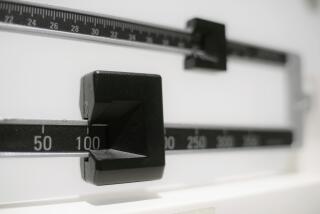Mellow setting puts fast food consumers in a mood to ... eat less
- Share via
Let’s face it: Eating at a fast food restaurant is not about the ambience. It’s fast, and its music and lighting seem geared to on-the-fly dining -- sort of laundromat-meets-elevator.
But did it ever ever occur to you that meals served amid bright lights and intrusive contempo-jazz might contribute to overeating? Or that dimming the lights a tad and soothing the pace of that frenetic soundtrack might have the opposite effect? A new study, published this week in Psychological Reports: Human Resources and Marketing, says it does -- and fast-food restaurants could institute such changes without fear of losing money.
Two “food psychologists” -- Brian Wansink of Cornell University and Koert van Ittersum of the University of Georgia -- were allowed to take over a Hardee’s restaurant in Champaign, Ill., and did a little redecorating before welcoming in customers -- er, subjects.
As customers arrived, generally in groups of two to four, 33 were randomly directed to the usual Hardee’s seating area: bright lights, upbeat music, energizing primary colors and hard, noise-reflecting surfaces. Twenty-nine others were directed to a back area that had been spruced up with window shades, white tablecloths, indirect lighting, tasteful plants, candles on the tables and paintings on the walls. Soft, instrumental jazz-ballads replaced Hardee’s customary soundtrack. The diners in this condition were told it was a new “thing” the restaurant was trying out.
Wansink, van Ittersum and others have experimentally manipulated dining experiences for some time, and their findings have been inconsistent: In some circumstances, soft lighting causes diners to eat and drink more -- probably because they feel less inhibited and less aroused. Soft lighting also appear to promote lingering and, hence, greater consumption.
Other studies have found little difference in consumption with such changes. But Wansink and van Ittersum have gone on record that getting too relaxed in a restaurant may be a formula for overeating.
But when Wansink and van Ittersum compared the orders and intake of the customers in the usual Hardee’s atmosphere to those of diners who sat in Hardee’s soft-lighting-and-music area, they found that the latter diners ordered the same number of calories worth of food and spent about the same amount. But they ate it more slowly -- 4.7% more slowly -- and left more of the food they’d ordered on their plate, uneaten.
On average, the soft-lights-and-music crowd consumed 133 fewer calories than did the fast-food customers in the unmodified Hardee’s restaurant area (525 calories for the fast food diners vs. 658 calories for the fast food customers).
Upon leaving, those diners rated the quality of the food they had eaten more highly than had those who had the typical fast-food experience.
“Even when people stayed longer, they ate less,” the authors said. And debriefings with some diners revealed why. Those eating their fast food under the influence of dimmer lights and softer music told researchers they ate more slowly and, as they took more time, their food became less appealing, so they stopped eating it earlier. “They might have been more responsive to internal cues than external cues,” the authors wrote.
“The authors’ previous warning not to eat too much in relaxing situations may have been premature,” they said.
Food psychologists have played with lots of conditions that seem to pare consumers’ consumption, including smaller plates, smaller portions and surroundings of different colors. Revamping the fast-food experience, where many Americans take in loads of calories in a short-sitting, may be the new frontier.







